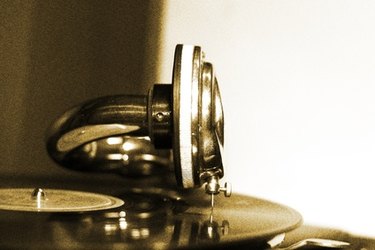Things You'll Need
Lithography pencil or crayon
Lithographic ink
Limestone or metal plates
Turpentine
Talc
Rosin
Sponge
Gum arabic
Lithographic roller
Lithography press
Lithography paper

How to Make a Lithograph. A lithograph is a planographic or surface printing process that depends on the chemical aversion of grease and water. This makes certain parts of the surface accept the ink and other parts reject the ink. Nineteenth century artists who used lithography include Honore Daumier and Toulouse-Lautrec. Numerous artists used this popular method of printmaking in the 20th century, including Salvador Dali, M. C. Escher and Jasper Johns.
Step 1
Draw an image in reverse on a limestone or a zinc or aluminum plate. Use lithography pencils or crayons. You will need to prepare a separate stone or plate for each color in the finished lithograph.
Video of the Day
Step 2
Sprinkle rosin on the surface to protect the drawing. Then powder with talc. This helps the chemical etch lie more closely to the grease in the drawing.
Step 3
Apply the etch, which is a solution of gum Arabic and nitric acid, to the stone and leave it on for an hour or so. Remove the drawing with a solvent like turpentine. The printing inks, which are also greasy, will adhere to where the drawing was.
Step 4
Sponge the stone or plate with water. The stone's surface is kept wet so the ink doesn't stick to non-image areas.
Step 5
Load damp paper in the lithography press. Run through the press. The ink remains on the roller when it meets water and transfers from the roller when it meets the grease. When you lift the paper, you get a reverse print. The first prints are trial proofs.
Step 6
Make pencil marks on each sheet of paper to be printed and line them up to correspond with marks on each stone or plate. The same piece of paper goes through the press for each different color, so these registration marks are really important in order to keep the colors aligned.
Step 7
Sign the final proof, called a "bon a tirer," meaning "good to pull," when you are satisfied. Now print the images. After the prints are complete, sign and number them.
Tip
Editions are all impressions of a printed image after artist approval including the "bon a tirer." Artist proofs are impressions set aside for artist's personal use. After you finish your edition, erase or break the stone or plate so no more impressions are printed. If you don't have a press, check to see if you can find a lithography press to use at a college department or print workshop.
Video of the Day